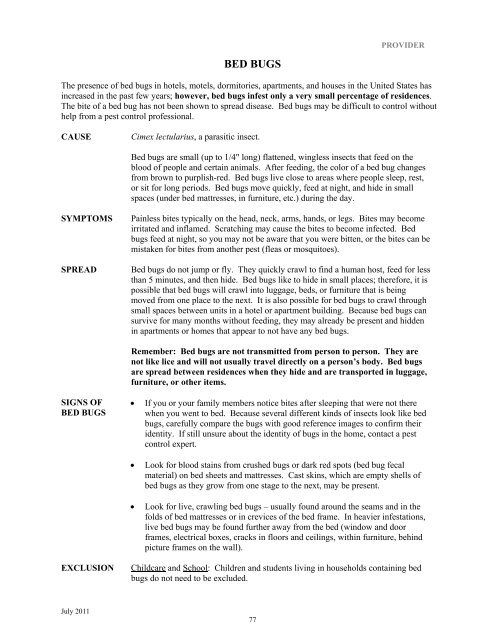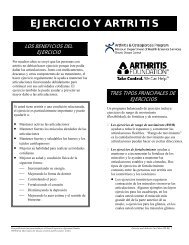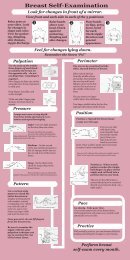Prevention and Control of Communicable Diseases - Missouri ...
Prevention and Control of Communicable Diseases - Missouri ...
Prevention and Control of Communicable Diseases - Missouri ...
Create successful ePaper yourself
Turn your PDF publications into a flip-book with our unique Google optimized e-Paper software.
July 2011<br />
BED BUGS<br />
77<br />
PROVIDER<br />
The presence <strong>of</strong> bed bugs in hotels, motels, dormitories, apartments, <strong>and</strong> houses in the United States has<br />
increased in the past few years; however, bed bugs infest only a very small percentage <strong>of</strong> residences.<br />
The bite <strong>of</strong> a bed bug has not been shown to spread disease. Bed bugs may be difficult to control without<br />
help from a pest control pr<strong>of</strong>essional.<br />
CAUSE Cimex lectularius, a parasitic insect.<br />
Bed bugs are small (up to 1/4" long) flattened, wingless insects that feed on the<br />
blood <strong>of</strong> people <strong>and</strong> certain animals. After feeding, the color <strong>of</strong> a bed bug changes<br />
from brown to purplish-red. Bed bugs live close to areas where people sleep, rest,<br />
or sit for long periods. Bed bugs move quickly, feed at night, <strong>and</strong> hide in small<br />
spaces (under bed mattresses, in furniture, etc.) during the day.<br />
SYMPTOMS Painless bites typically on the head, neck, arms, h<strong>and</strong>s, or legs. Bites may become<br />
irritated <strong>and</strong> inflamed. Scratching may cause the bites to become infected. Bed<br />
bugs feed at night, so you may not be aware that you were bitten, or the bites can be<br />
mistaken for bites from another pest (fleas or mosquitoes).<br />
SPREAD Bed bugs do not jump or fly. They quickly crawl to find a human host, feed for less<br />
than 5 minutes, <strong>and</strong> then hide. Bed bugs like to hide in small places; therefore, it is<br />
possible that bed bugs will crawl into luggage, beds, or furniture that is being<br />
moved from one place to the next. It is also possible for bed bugs to crawl through<br />
small spaces between units in a hotel or apartment building. Because bed bugs can<br />
survive for many months without feeding, they may already be present <strong>and</strong> hidden<br />
in apartments or homes that appear to not have any bed bugs.<br />
SIGNS OF<br />
BED BUGS<br />
Remember: Bed bugs are not transmitted from person to person. They are<br />
not like lice <strong>and</strong> will not usually travel directly on a person’s body. Bed bugs<br />
are spread between residences when they hide <strong>and</strong> are transported in luggage,<br />
furniture, or other items.<br />
� If you or your family members notice bites after sleeping that were not there<br />
when you went to bed. Because several different kinds <strong>of</strong> insects look like bed<br />
bugs, carefully compare the bugs with good reference images to confirm their<br />
identity. If still unsure about the identity <strong>of</strong> bugs in the home, contact a pest<br />
control expert.<br />
� Look for blood stains from crushed bugs or dark red spots (bed bug fecal<br />
material) on bed sheets <strong>and</strong> mattresses. Cast skins, which are empty shells <strong>of</strong><br />
bed bugs as they grow from one stage to the next, may be present.<br />
� Look for live, crawling bed bugs – usually found around the seams <strong>and</strong> in the<br />
folds <strong>of</strong> bed mattresses or in crevices <strong>of</strong> the bed frame. In heavier infestations,<br />
live bed bugs may be found further away from the bed (window <strong>and</strong> door<br />
frames, electrical boxes, cracks in floors <strong>and</strong> ceilings, within furniture, behind<br />
picture frames on the wall).<br />
EXCLUSION Childcare <strong>and</strong> School: Children <strong>and</strong> students living in households containing bed<br />
bugs do not need to be excluded.
















